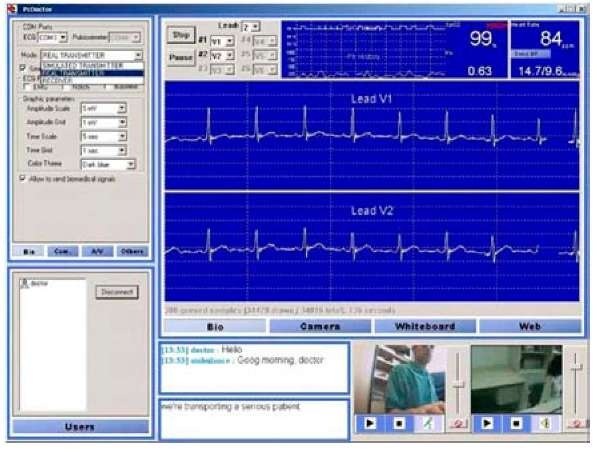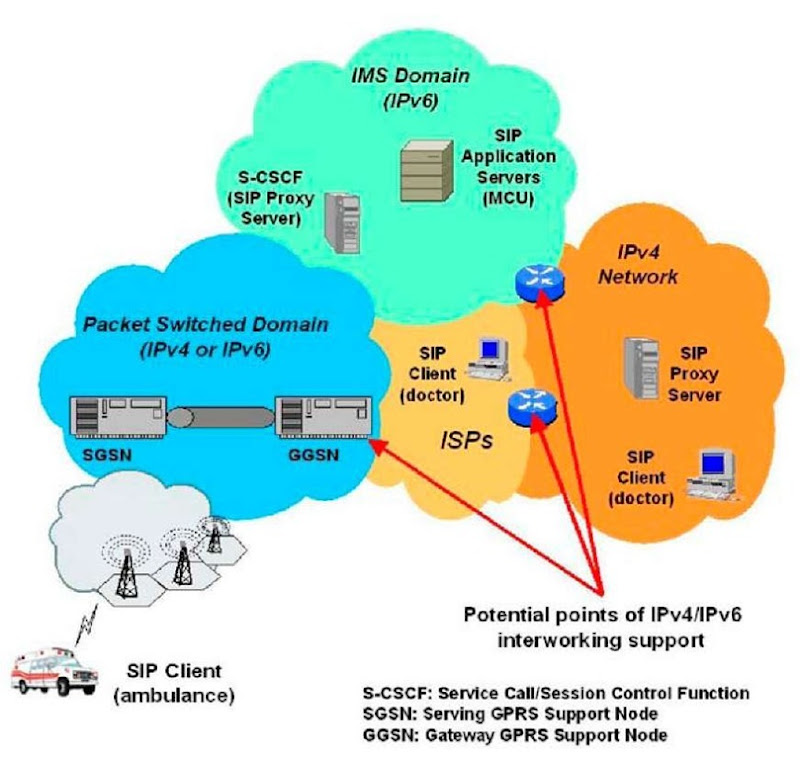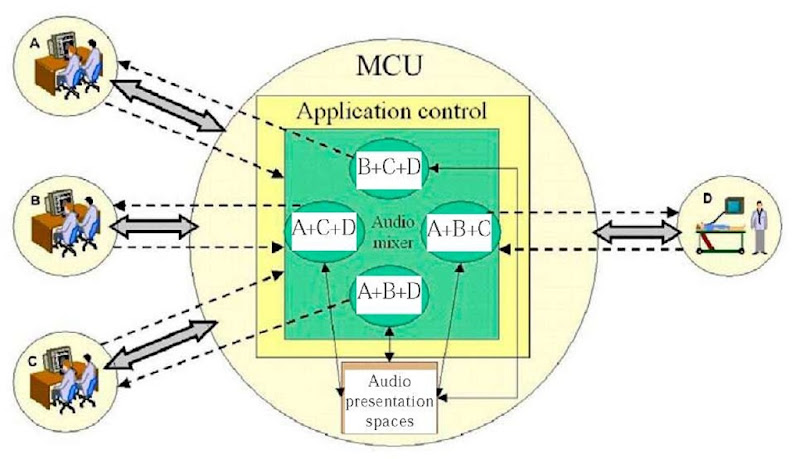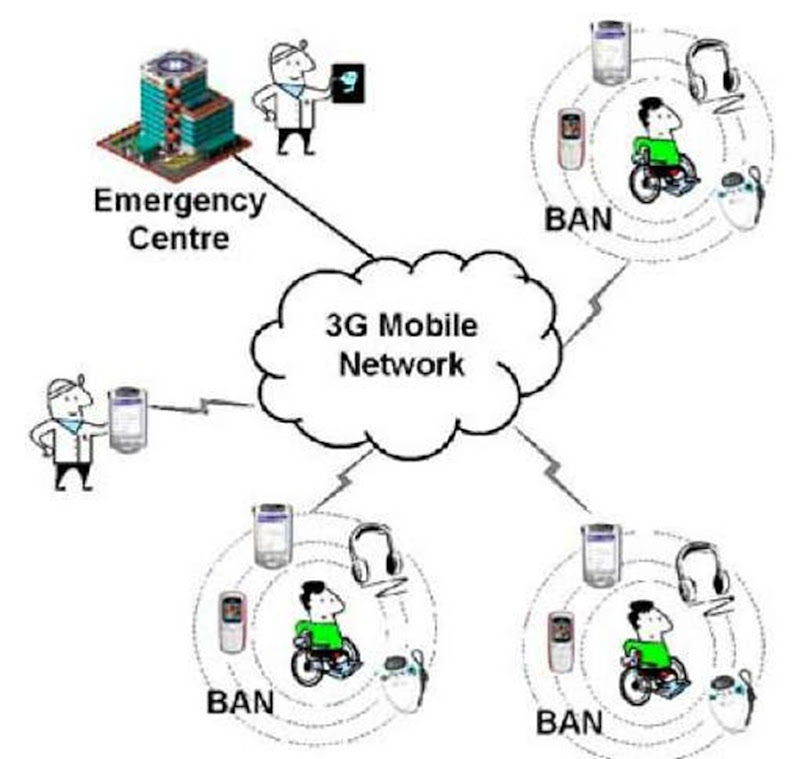abstract
An enhanced mobile healthcare multi-collaborative system operating over Third Generation (3G) mobile networks is presented. This topic describes the design and use of this system in different medical and critical emergency scenarios provided with universal mobile telecommunications system (UMTS) accesses. In these environments, it is designed to communicate healthcare personnel with medical specialists in a remote hospital. The system architecture is based on advanced signalling protocols that allow multimedia multi-collaborative conferences in IPv4/IPv6 3G scenarios. The system offers real-time transmission of medical data and videoconference, together with other non real-time services. It has been optimized specifically to operate over 3G mobile networks using the most appropriate codecs. Evaluation results show a reliable performance over IPv4 UMTS accesses (64 Kbps in the uplink). In the future, advances in m-Health systems will make easier for mobile patients to interactively get the medical attention and advice they need.
introduction
Mobile health (m-health) is an emerging area of telemedicine in which the recent development in mobile networks and telemedicine applications converge. m-health involves the exploitation of mobile telecommunication and multimedia technologies and their integration into new mobile healthcare delivery systems (Istepanian & Lacal, 2003). Wireless and mobile networks have brought about new possibilities in the field of telemedicine thanks to the wide coverage provided by cellular networks and the possibility of serving moving vehicles. One of the first wireless telemedical systems that utilized second-generation (2G) global system for mobile communications (GSM) networks addressed the electrocardiogram (ECG) transmission issues (Istepanian, 2001a). In recent years, several m-health and wireless telemedical systems based on GSM were reported (Istepanian, 2001b), allowing the accomplishment of remote diagnosis in mobile environments, as well as communication to geographic zones inaccessible by wired networks. The recent developments in digital mobile telephonic technologies (and their impact on mobility issues in different telemedical and telecare applications) are clearly reflected in the fast growing commercial domain of mobile telemedical services. A comprehensive review of wireless telemedicine applications and more recent advances on m-health systems is presented in Istepanian, Laxminarayan, and Pattichis (2005).
However, 2G-based systems lack the necessary bandwidth to transmit bandwidth-demanding medical data. The third-generation (3G) universal mobile telecommunications system (UMTS) overcomes limitations of first and second mobile network generations supporting a large variety of services with different quality of service (QoS) requirements. However, this fact makes network design and management much more complex. New applications require networks to be able to handle services with variable traffic conditions keeping the efficiency in the network resources utilization. The UMTS air interface is able to cope with variable and asymmetric bit rates, up to 2 Mbps and 384 kbps in indoor and outdoor environments, respectively, with different QoS requirements such as multimedia services with bandwidth on demand (Laiho, Wacker, & Novosad, 2000). In this kind of scenario, the emergence of 3G mobile wireless networks will permit to extend the use of m-health applications thanks to the provided higher transmission rates and flexibility over previous mobile technologies.
UMTS introduces the IP multimedia core network subsystem (IMS) (3GPP, 2005a), an IPv6 network domain designed to provide appropriate support for real-time multimedia services, independence from the access technologies and flexibility via a separation of access, transport and control. The fundamental reason for using IPv6 is the exhaustion of IPv4 addresses. Support for IPv4 is optional, but since network components require backward compatibility, it is clear that a dual stack configuration (IPv4 and IPv6) must be provided. The IMS uses the session initiation protocol (SIP) as signalling and session control protocol (Rosenberg et al., 2002). SIP allows operators to integrate real-time multimedia services over multiple access technologies such as general packet radio service (GPRS), U MTS or, ultimately, other wireless or even fixed network technologies (interworking multimedia domains). This topic presents a 3G-based m-health system designed for different critical and emergency medical scenarios, as shown in Figure 1. Several medical specialists in the hospital take part in a multipoint conference with the ambulance personnel, receiving compressed and coded biomedical information from the patient, making it possible for them to assist in the diagnosis prior to its reception.
The 3G system software architecture includes intelligent modules such as information compression and coding, and QoS control to significantly improve transmission efficiency, thus optimizing the use of the scarce and variable wireless channel bandwidth compared to previous systems (Chu & Ganz, 2004; Curry & Harrop, 1998). Finally, unlike Chu and Ganz (2004), this m-health system follows a multi-collaborative design which supports IPv6/IPv4 interworking, uses SIP as the service control protocol and integrates new real-time multimedia features intended for 3G wireless networks .
Figure 1. Typical medical mobility scenario
3G M-HEALTH system architecture
In this section, the 3G m-health system structure is described in detail. The system (see the system com ponents in Figure 2 and the main application graphical user interface (GUI) i n Figure 3) has been built using standard off-the-shelf hardware, instead of developing prop riety hardware as in Cullen, Gaasch, Gagliano, Goins, and Gu-nawardane (2001), uses free softwa re and commercially avanable 3G wireless UMTS c eUular data serviees. Inaddition, itprovides simultaneous transfer of, among ot her services, videoconCer-ence, high-resolution stUl medical images and medical (data, rather than only one med-a at a time (Kyriacou , C003; Pavlopoulos, Kyriocou, Berler, Dembeyiotis, & Koutsouris, b998o
The 3G m-health system consists of different modules that allow the acwuisitiar^, treatment, repreeentation anC transmission of multimedia information. The modular d^sagn of each medica l user servicc allows greet flexibility. Ic odditioc, there exist other medical usecservices like chat and electronic whiteboard -hat allow/ data exchange in order to guide the ederations performed by remore users.
The medical signals module acquires, com-precses, coodes, r epreaents, and transmits medical signals in real time. The medical sigoals acquisition devices included are: a portable electrocar-diegraoh that allows the acquisition of 8 real and 4 interpolated leads of the ECG signal, and that follows the standard communication protocol-ECG (SCP-ECG); a tensiometer that provides systolic and diastolic blood pressure values; and a pulsioximeter that offers the blood oxygen saturation level (SpO2) and the cordiac pulse.
The details of the OG system architecture are shown in pige 4 and Figure 5. As i) can be seen, the system comprises of the signalling and session control, medical user services and application cnntrol sub-systems, which will be dnscribed later.
Figure 2. 3G m-Health system
This architecture allows the 3G system to offer real-time services such as medical data transmission (ECG, bloo d pressure, heart rate and oxygen saturation), full-duplex videoconfer-ence, high-resolution still imagee, chat, electronie mhiteboard, and remote database Web access.
Figure 3. m-Health application GUI
Signaling and session
The developed signallmg allows the exchange oh the characteristics assooiated to the differ-ebnats einfWorembataicocnesflso.ws between system elements and is based on standard protocols that favour interoperability. Signalling a^skse performed by thb SIP protocol, begin with toe establishment of a SHIP dialog with the MCU in whieh, !y means o! session Oescription protpcot (SDP) messeges, thp different serveces are described. In order to do ehae, each element in the system has a SIP user coene (UA), slighely modificdin the MCU to allow the use of multiple simultaneous dialogs.
Figure 4. 3G network scenario
Figure 5. Block diagram of the m-Health system architecture and sub-systems
In addition to session control functions (establishment, management and termination of the multipoint conference), the SIP protocol is also useful for user mobility purposes inside the IMS environment.
Multipoint conference establishment, management and termination is performed by exchanging SIP messages between the different users. When a user connects, he creates a SIP dialog with the MCU, joining the conference. During the conference, SIP messages are exchanged between users and the MCU, varying conference characteristics and therefore allowing its management. In a similar process to that of conference joining, when a user wants to leave it, this fact must be communicated to the MCU with the necessary SIP messages. SIP messages also serve as the mean of transport of SDP messages with the description of medical user services.
The fos in this system is mainly determined by the characteristics of the UMTS link. Mobile links are very variable, therefore a QoS-monitor-ing process is required in order to obtain a good system performance. This process is especially important in the MCU because it is there where the QoS-related decisions are taken. When the MCU detects that a particular conference participant needs to modify the characteristics of its multimedia session in order to improve QoS, it renegotiates the corresponding session by sending SIPiSDP messages. Hence, conference participants can modify certain upper-level protocol parameters (codecs used, transmission rates, compression ratios, etc.) in order to adapt the transmitted information to network performance.
The QoS monitoring process is possible thanks to a transport library that provides a uniform interface to send the information generated by medical user services and different QoS estimation tools developed for several types of links. This transport library offers different queuing policies and tools designed to measure the following QoS-related parameters: delay, bandwidth and packet loss rate. Due to the variable nature of wireless links, reception buffers have been properly dimensioned to minimize jitter, delay and packet loss.
Wireless Medical User services
The medical user services included in the m-health system are associated with information shared in a multi-collaborative environment. Specifically, the system has services to share audio, video, medical data information, high-resolution still images, and graphical and textual information, as well as a Web service that allows remote access to clinical information databases. In addition to these services, there is a service designed to exchange control information (application control), which is discussed later.
Each kind of information is associated with a medical user service and uses a transport protocol and a codec according to its characteristics (see Table 1). Hence, real-time services (audio, video, and medical data information) use the real-time transport protocol (RTP), whereas the rest of the services use the transmission control protocol (TCP). Furthermore, the exchanged information can be very sensitive and requires a secure communication. The 3G m-health system uses an IP security protocol (IPSec) implementation supporting public key certificates in tunnel mode. This protocol ensures private communication of selected services.
The ECG signal is stored both in transmission and reception following the SCP-ECG standard. It is well known that for an efficient transmission an ECG compression technique has to be used. In our implementation, a real-time ECG compression technique based on the wavelet transform is used (Alesanco, Olmos, Istepanian, & Garcia, 2003). This is a lossy compression technique, therefore the higher the compression ratio (lower the transmission rate), the higher the distortion at reception. It is clear that there is a trade-off between transmission rate and received ECG signal quality. From the transmission efficiency point of view, a very low transmission rate is desired but from the clinical point of view, a very distorted ECG is useless. Therefore, there exists a minimum transmission rate to be used so as the transmitted ECG is useful for clinical purposes, which was selected in collaboration with cardiologists after different evaluation tests. The minimum transmission rate used in our implementation (625 bits per second and per ECG lead) leads to a clinically acceptable received ECG signal.
Table 1. Codec operation modes for 3G real-time wireless medical user services
|
|
CODEC |
CODEC RATE |
|
Audio |
AMR* |
4.74 5.15 5.9 6.7 7.4 7.95 10.0 12.2 (Kbps) |
|
Video |
H.263 |
5 10 (Frames per second) |
|
Biomedical Signals |
WT** |
5 10 20 (Kbps) |
* Adaptive Multi-rate
** Wavelet Transform
Regarding blood pressure, oxygen saturation, and heart rate, these signals have low bandwidth requirements and, therefore, are not compressed.
The videoconference module captures, sends, and plays audio and video information obtained by means of a Web camera and a microphone. In order to reduce the bandwidth, these data are compressed and coded. The video signal is compressed following the H.263 standard, whereas the audio signal uses the adaptive multi-rate (AMR) codec, recommended for UMTS by the 3G Partnership Program (3GPP) (3GPP 2005b). This module provides the basic functionality for starting, pausing and stopping video signals acquisition and representation, as well as volume control for the microphone (capture) and the speakers (reproduction). Due to the fact that each participant in the conference receives a unique video signal, the system allows the user to select the particular video signal among all the users connected.
The high-resolution still image module obtains high quality images with a charge copled device (CCD) colour camera connected to the computer through an image acquisition card. This module includes options to preview the captured images and modify their main characteristics in real time: brightness, contrast, hue, etc. Captured images can be stored and transmitted in different formats, with various qualities and compression levels. These images are sent automatically to the electronic whiteboard module of the remote users, allowing to select and mark fixed areas in a multi-collaborative fashion to facilitate a diagnostic clinical procedure.
Application control
The MCU forwards the information generated by each medical service according to the presentation spaces defined using the control service. Each medical service has a presentation space associated with it that defines the way in which the information has to be transferred and its destination. The MCU simply forwards the information it receives, but has a special treatment for the audio, video, medical data, and control services. Regarding the Audio service, the MCU decodes the signal of each user, mixes it with the decoded signal of the other conference participants and codes the result in order to transfer a unique audio signal to each user (Figure 6). On the other hand, the MCU only forwards one video signal to each conference participant. The particular video signal forwarded to each user is selected by using the control service. Finally, the medical data service is similar to the video service: medical data are only generated in the remote location, whereas the other conference participants can only receive them.
Figure 6. Application control (audio presentation spaces)
The 3G m-health system was adapted to the critical and emergency medical scenarios. In the first stages of its design, user requirements and functional specifications were established in collaboration with medical specialists, in order to create a portable and modular m-health system that could be easily integrated in any environment, using any underlying network technology capable of supporting IP multimedia services
3G M-Health system performance
In order to measure the 3G m-health system performance, several tests have been carried out using the system over 64 Kbps (at IP level) UMTS accesses. Table 2 presents the results about average IP-level bandwidth used by real-time network services.
As it can be observed, considering more audio samples per network packet reduces the used bandwidth, since transmission efficiency (information carried by each packet to total packet size ratio) is increased. However, there is a limit in the number of audio samples per packet that can be used because more audio samples per packet yield more audio delay. For example, a more efficient transmission mode including four audio samples per packet every 80 ms causes four times the delay including only one audio sample per packet every 20 ms. Moreover, if an audio packet is lost, all the audio samples carried by it are lost and, therefore, a reduced number of audio samples per packet is more suitable to error-prone environments. Regarding the video user service, it is worth noting that the bandwidth shown in Table 2 can vary substantially with the movement of the video scene captured. Finally, the medical data service adapts well to the codec rate specified because medical data frame sizes are long enough to obtain a good transmission efficiency.
As it can be checked, the total bandwidth consumed by all real-time medical user services fits in a 64 Kbps UMTS channel, even when the most bandwidth-consuming codec rates and the lowest transmission efficiencies are used. If all medical user services are used (including non real-time services), lower codec rates should be selected. Thus, according to the previous discussions, the codec operation modes selected in this m-health system have been those highlighted in Table 2, achieving a reasonable trade-off between bandwidth, transmission efficiency, delay and loss ratio.
Table 2. Average IP-level bandwidth used by real-time user services
|
Operation Mode |
IP Bandwidth (Kbps) |
|
|
Audio |
Samples packet Codec rate (Kbps) |
|
|
1 4.75 |
21.2 |
|
|
1 12.2 |
28.8 |
|
|
3 4.75 |
10.5 |
|
|
3 12.2 |
18.1 |
|
|
Video |
Frames per Second |
|
|
5 |
16 |
|
|
10 |
24 |
|
|
Biomedical |
Bit Rate |
|
|
Signals |
5 |
5.3 |
|
10 |
10.3 |
NEXT-GENERATION OF M-HEALTH SYSTEMS
It is evident that organizations and the delivery of health care are being underpinned by the advances in m-health technologies. In the future, home medical care and remote diagnosis will become common, check-up by specialists and prescription of drugs will be enabled at home and virtual hospitals with no resident doctors will be realized.
Hence, the deployment of emerging mobile and wireless technologies will face new challenges: inter-operability between heterogeneous networks (fourth-generation, 4G) and smart medical sensor design integrating sensing, processing, communications, computing, and networking.
With the aid of wireless intelligent medical sensor technologies, m-health can offer healthcare services far beyond what the traditional telemedical systems can possibly provide. The individual sensors can be connected wirelessly to a personal monitoring system using a wireless body area network (WBAN) and can be integrated into the user’s clothing, providing wearable and ubiquitous m-health systems. A typical scenario comprises of a WBAN system that communicates with cardiac implantable devices (pacemakers, defibrillators, etc.) and that is linked to the existing 3G infrastructure, achieving “Health Anytime, Anywhere” (Figure 7).
It is expected that 4G will integrate existing wireless technologies including UMTS, wireless LAN, Bluetooth, ZigBee, Ultrawideband, and other newly developed wireless technologies into a seamless system. Some expected key features of 4G networks are: high usability, support for multimedia services at low transmission cost and facilities for integrating services. 4G advances will make easier for mobile patients to interactively get the medical attention and advice they need. When and where is required and how they want it regardless of any geographical barriers or mobility constraints.
Figure 7. Typical WBAN-3G S3enario
The concept of including high-speed data and other services integrated with voice services is emerging as one of the main points of future telecommunication and multimedia priorities with the relevant benefits to citizen-centered healthcare systems. The new wireless technologies will allow both physicians and patients to roam freely, while maintaining access to critical patient data and medical knowledge.
conclusion
This topic has presented a feasible 3G-based m-health system targeted specifically for critical and emergency medical scenarios. The system architecture is based on 3G networks and advanced signalling protocols (SIP/SDP) that allow the integration of real-time multimedia services over multiple access channels that support IPv4 and IPv6 interworking depending on current commercial UMTS releases.
The system has the following features: simultaneous transmission of real-time clinical data (incluhmg ECG signals, blood pressure, and blood oxygen saturation), videoconOerence, high-resolution stmll image transmission, and oth er facilities such as multi-collaborative whiteboard, chat, and Web access to remote databases. The system has been optimized specifically to operate over 3G mobile networks using the most appropriate codecs. Evaluation results show a reliable performance over UMTS accesses (64 Kbps in the uplrnk).
Home telecara and cheonk: patient telemonitoring are other application areas on which this m-health system can b e used, thus further work is currently undergone to adapt it and t o evaluate its performance in each particular scenario.
KEY TERMs
4G: The fourth-generation (4G) is the continuation of the first, second, and third generations of mobile networks. It is a wireless access technology that provides high-speed mobile wireless access with a very high data transmission speed (2-20 Mbps) and enables users to be simultaneously connected to several wireless access technologies and seamlessly move between them in an all-IP environment. These access technologies can be any existing or future access technology. Smart antennas, low power consumption, and software-defined radio terminals will also be used to achieve even more flexibility for the user of 4G systems.
IMS: The IP multimedia subsystem (IMS) is a new open and standardized framework, basically specified for mobile networks, for providing Internet protocol (IP) telecommunication services. It offers a next generation network (NGN) multimedia architecture for mobile and fixed services, based on the session initiation protocol (SIP), and runs over the standard IP. It is used by telecom operators in NGN networks (combining voice and data in a single packet switched network), to offer network controlled multimedia services. The aim of IMS is not only to provide new services but to provide all the services, current and future, that the Internet provides. In addition, users have to be able to execute all their services when roaming as well as from their home networks. To achieve these goals the IMS uses IETF protocols. This is why the IMS merges the Internet with the cellular world; it uses cellular technologies to provide ubiquitous access and Internet technologies to provide new services.
IPv6: Internet protocol version 6 (IPv6) is the next generation protocol designed by the Internet Engineering Task Force (IETF) to replace the current version of the Internet protocol, IP version 4 (IPv4). Today’s Internet has been using IPv4 for twenty years, but this protocol is beginning to become outdated. The most important problem of IPv4 is that there is a growing shortage of IPv4 addresses, which are needed by all new machines added to the Internet. IPv6 is the solution to several problems in IPv4, such as the limited number of available IPv4 addresses, and also adds many improvements to IPv4 in other areas. IPv6 is expected to gradually replace IPv4, with the two coexisting for a number of years during a transition period.
QoS: ITU-T recommendation E.800 defines the term quality of service (QoS) as “the collective effect of service performance which determines the degree of satisfaction of a user of the service.” Service performance comprises of very different parts (security, operability, etc), so the meaning of this term is very broad. In telecommunications, the term QoS is commonly used in assessing whether a service satisfies the user’s expectations. QoS evaluation, however, depends on functional components and is related to network performance via measurable technical parameters. A QoS-enabled network has the ability to provide better service (priority, dedicated bandwidth, controlledjitter, latency, and improved loss characteristics) to selected network traffic over various technologies.
SIP: The session initiation protocol (SIP) is a signalling protocol developed by the IETF intended for setting up multimedia communication sessions between one or multiple clients. It is currently the leading signalling protocol for voice over IP, and is one of the key components of the IMS multimedia architecture. The most important functions of SIP include name mapping and redirection (user location), capabilities negotiation during session setup, management of session participants and capabilities management during the session.
Telemedicine: Telemedicine can be defined as the rapid access to shared and remote medical expertise by means of telecommunications and information technologies, no matter where the patient or the relevant information is located. Any application of information and communications technologies which removes or mitigates the effect of distance in healthcare is telemedicine. The terms e-health and tele-health are terms often interchanged with telemedicine.







